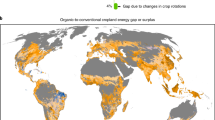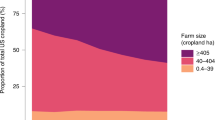Abstract
The debate about organic farming productivity has often focused on its relative crop yields compared with conventional farming. However, conversion to organic farming not only results in changes in crop yields, but also in changes in the types of crops grown. To date, the effects of such changes on global crop production have never been systematically investigated. Here, we provide a novel, spatially explicit estimation of the distribution of crop types grown, as well as crop production, under a scenario of 100% conversion of current cropland to organic farming. Our analysis shows a decrease of −31% harvested area, with primary cereals (wheat, rice and maize) compensated by an increase in the harvested areas with temporary fodders (+63%), secondary cereals (+27%) and pulses (+26%) compared with the conventional situation. These changes, paired with organic-to-conventional yield gaps, lead to a −27% gap in energy production from croplands compared with current production. We found that ~1/3 of this gap is explained by changes in the types of crops grown (a contribution rising to 50% when focusing on food crops only), and that such changes strongly affect the repartition of total production among different crop types. Feeding the world organically would thus require profound adaptations of human diets and animal husbandry.
This is a preview of subscription content, access via your institution
Access options
Access Nature and 54 other Nature Portfolio journals
Get Nature+, our best-value online-access subscription
$29.99 / 30 days
cancel any time
Subscribe to this journal
Receive 12 digital issues and online access to articles
$119.00 per year
only $9.92 per issue
Buy this article
- Purchase on Springer Link
- Instant access to full article PDF
Prices may be subject to local taxes which are calculated during checkout




Similar content being viewed by others
Data availability
All of the parameters and variables used are reported in the Supplementary Information. The full code is available from the corresponding author upon request.
References
Agriculture at a Crossroads. International Assessment of Agricultural Knowledge, Science and Technology for Development (AASTD) Global Report 320 (IAASTD, 2009).
Foley, J. A. et al. Solutions for a cultivated planet. Nature 478, 337–342 (2011).
Steffen, W. et al. Planetary boundaries: guiding human development on a changing planet. Science 347, 1259855 (2015).
Connor, D. J. Organic agriculture cannot feed the world. Field Crops Res. 106, 187–190 (2008).
Connor, D. J. & Mínguez, M. I. Evolution not revolution of farming systems will best feed and green the world. Glob. Food Sec. 1, 106–113 (2012).
Connor, D. J. Organically grown crops do not a cropping system make and nor can organic agriculture nearly feed the world. Field Crops Res. 144, 145–147 (2013).
Kirchmann, H., Bergström, L., Kätterer, T. & Andersson, R. Dreams of Organic Farming: Facts and Myths (Fri tanke förlag, 2016).
Seufert, V., Ramankutty, N. & Foley, J. Comparing the yields of organic and conventional agriculture. Nature 485, 229–232 (2012).
De Ponti, T., Rijk, B. & Van Ittersum, M. K. The crop yield gap between organic and conventional agriculture. Agric. Syst. 108, 1–9 (2012).
Erb, K. et al. Exploring the biophysical option space for feeding the world without deforestation. Nat. Commun. 7, 11382 (2016).
Muller, A. et al. Strategies for feeding the world more sustainably with organic agriculture. Nat. Commun. 8, 1290 (2017).
Bachinger, J. & Zander, P. ROTOR, a tool for generating and evaluating crop rotations for organic farming systems. Eur. J. Agron. 26, 130–143 (2007).
Puech, C., Baudry, J., Joannon, A., Poggi, S. & Aviron, S. Organic vs. conventional farming dichotomy: does it make sense for natural enemies? Agric. Ecosyst. Environ. 194, 48–57 (2014).
Lampkin, N. Organic Farming (Farming Press Books, 1990).
Kremen, C., Iles, A. & Bacon, C. Diversified farming systems: an agroecological, systems-based alternative to modern industrial agriculture. Ecol. Soc. 17, 44 (2012).
Rusch, A., Bommarco, R., Jonsson, M., Smith, H. G. & Ekbom, B. Flow and stability of natural pest control services depend on complexity and crop rotation at the landscape scale. J. Appl. Ecol. 50, 345–354 (2013).
Barbieri, P., Pellerin, S. & Nesme, T. Comparing crop rotations between organic and conventional farming. Sci. Rep. 7, 13761 (2017).
Willer, H. & Lernoud, J. The World of Organic Agriculture. Statistics and Emerging Trends 2017 (FIBL & IFOAM Organics International, 2017).
Badgley, M. C. et al. Organic agriculture and the global food supply. Renew. Agr. Food Syst. 22, 86–108 (2007).
Monfreda, C., Ramankutty, N. & Foley, J. A. Farming the planet: 2. Geographic distribution of crop areas, yields, physiological types, and net primary production in the year 2000. Glob. Biogeochem. Cycles 22, GB1022 (2008).
Ponisio, L. C. et al. Diversification practices reduce organic to conventional yield gap. Proc. R. Soc. B 282, 20141396 (2015).
Tayleur, C. & Phalan, B. Organic farming and deforestation. Nat. Plants 2, 16098 (2016).
FAOSTAT Statistics Database (Food and Agriculture Organization of the United Nations, 2016); http://www.fao.org/faostat/en/#data
Cassidy, E. S., West, P. C., Gerber, J. S. & Foley, J. A. Redefining agricultural yields: from tonnes to people nourished per hectare. Environ. Res. Lett. 8, 034015 (2013).
Gustavsson, J., Cedeberg, C. & Sonesson, U. Global Food Losses and Food Waste. Extent, Causes and Prevention (FAO, 2011).
Wilkinson, J. M. Re-defining efficiency of feed use by livestock. Animal 5, 1014–1022 (2011).
Seufert, V. & Ramankutty, N. Many shades of gray—the context-dependent performance of organic agriculture. Sci. Adv. 3, e1602638 (2017).
Poveda, K., Gomez, M. & Martinez, E. Diversification practices: their effect on pest regulation and production. Rev. Colomb. Entomol. 34, 131–144 (2008).
Nowak, B., Nesme, T., David, C. & Pellerin, S. Nutrient recycling in organic farming is related to diversity in farm types at the local level. Agric. Ecosyst. Environ. 204, 17–26 (2015).
Alexander, P. et al. Losses, inefficiencies and waste in the global food system. Agric. Syst. 153, 190–200 (2017).
Lin, C. S. K. et al. Food waste as a valuable resource for the production of chemicals, materials and fuels. Current situation and global perspective. Ener. Environ. Sci. 6, 426–464 (2013).
Smith, L. C. & Haddad, L. Reducing child undernutrition: past drivers and priorities for the post-MDG era. World Dev. 68, 180–204 (2015).
Mie, A. et al. Human health implications of organic food and organic agriculture: a comprehensive review. Environ. Health 16, 111 (2017).
Baudry, J. et al. Association of frequency of organic food consumption with cancer risk. Findings from the NutriNet-Santé prospective cohort study. JAMA Intern. Med. 178, 1597–1606 (3018).
US Department of Agriculture and US Department of Health and Human Services. Dietary Guidelines for Americans 2010 7th edn (US Government Printing Office, 2010).
Mitchell, D. C., Lawrence, F. R., Hartman, T. J. & Curran, J. M. Consumption of dry beans, peas, and lentils could improve diet quality in the US population. J. Am. Diet. Assoc. 109, 909–913 (2009).
Pellegrini, L. & Tasciotti, L. Crop diversification, dietary diversity and agricultural income: empirical evidence from eight developing countries. Can. J. Dev. Stud. 35, 211–227 (2014).
Halberg, N., Sulser, T. B., Hogh-Jensen, H., Rosegrant, M. & Knudsen, M. T. in Global Development of Organic Agriculture: Challenges and Prospects 277–323 (CABI Publishing, 2006).
Schader, C. et al. Impacts of feeding less food-competing feedstuffs to livestock on global food system sustainability. J. R. Soc. Interface 12, 20150891 (2015).
Dong, H. et al. in IPCC Guidelines for National Greenhouse Gas Inventories Vol. 4, Ch. 10 (Institute for Global Environmental Strategies, 2006); https://www.ipcc-nggip.iges.or.jp/public/2006gl/index.html
Van Ittersum, M. K. et al. Can Sub-Saharan Africa feed itself? Proc. Natl Acad. Sci. USA 113, 14964–14969 (2016).
Van der Werf, E. Agronomic and economic potential of sustainable agriculture in South India. Am. J. Altern. Agric. 8, 185–191 (1993).
Panneerselvam, P., Hermansen, J. E. & Halberg, N. Food security of small holding farmers: comparing organic and conventional systems in India. J. Sustain. Agric. 35, 48–68 (2011).
Lotter, D. Facing food insecurity in Africa: why, after 30 years of work in organic agriculture, I am promoting the use of synthetic fertilizers and herbicides in small-scale staple crop production. Agr. Hum. Values 32, 111–118 (2014).
Reganold, J. P. & Wachter, J. M. Organic agriculture in the twenty-first century. Nat. Plants 2, 15221 (2016).
Licker, R. et al. Mind the gap: how do climate and agricultural management explain the ‘yield gap’ of croplands around the world? Glob. Ecol. Biogeogr. 19, 769–782 (2010).
Mueller, N. D. et al. Closing yield gaps through nutrient and water management. Nature 490, 254–257 (2012).
Kilcher, L. How organic agriculture contributes to sustainable development. J. Agric. Res. Trop. Subtrop. Suppl. 89, 31–49 (2007).
Alimentation des Bovins, Ovins et Caprins (INRA, 2007).
Food Standards Agency McCance and Widdowson’s The Composition of Foods (Royal Society of Chemistry, 2002).
Hijmans, R. et al. raster: Geographic data analysis and modeling. R package v.2.5-8 https://cran.r-project.org/web/packages/raster/raster.pdf (2016).
Bivand, R. et al. rgdal: Bindings for the ‘Geospatial’ Data Abstraction Library. R package v.1.2-7 https://cran.r-project.org/web/packages/rgdal/rgdal.pdf (2017).
Bivand, R. et al. rgeos: Interface to Geometry Engine–Open Source (‘GEOS’). R package v.0.3-23 https://cran.r-project.org/web/packages/rgeos/index.html (2017).
Brunsdon, C. & Chen, H. GISTools: Some further GIS capabilities for R. R package v.0.7-4 https://cran.r-project.org/web/packages/GISTools/GISTools.pdf (2015).
Pierce, D. ncdf4: Interface to Unidata NetCDF (version 4 or earlier) format data files. R package v.1.16 https://cran.r-project.org/web/packages/ncdf4/ncdf4.pdf (2017).
Calaway, R., Weston, S. & Tenenbaum, D. doParallel: For each parallel adaptor for the ‘parallel’ package. R package v.1.0.11 https://cran.r-project.org/web/packages/doParallel/index.html (2017).
Acknowledgements
We are grateful to M. Kvakic and B. Ringeval for suggestions and help with the model construction, and G. Wagman for improving the English. This work was funded by Bordeaux Sciences Agro (Université de Bordeaux) and the INRA-CIRAD GloFoodS metaprogramme.
Author information
Authors and Affiliations
Contributions
P.B., S.P., V.S. and T.N. designed the study. P.B. collected the data, coded the cropland management model and performed the calculations. All authors were involved in interpretation of the results and contributed to writing and revising the manuscript.
Corresponding author
Ethics declarations
Competing interests
The authors declare no competing interests.
Additional information
Publisher’s note: Springer Nature remains neutral with regard to jurisdictional claims in published maps and institutional affiliations.
Supplementary information
Supplementary Information
Supplementary Methods, Supplementary Tables 1–12, Supplementary Figures 1–5, Supplementary References 1–6
Rights and permissions
About this article
Cite this article
Barbieri, P., Pellerin, S., Seufert, V. et al. Changes in crop rotations would impact food production in an organically farmed world. Nat Sustain 2, 378–385 (2019). https://doi.org/10.1038/s41893-019-0259-5
Received:
Accepted:
Published:
Issue Date:
DOI: https://doi.org/10.1038/s41893-019-0259-5
This article is cited by
-
Soil organic carbon stocks potentially at risk of decline with organic farming expansion
Nature Climate Change (2023)
-
Crop rotation and inoculation increase soil bradyrhizobia population, soybean grain yields, and profitability
Brazilian Journal of Microbiology (2023)
-
Impact of cropping systems on pedogenic distribution and transformations of micronutrients, plant accumulation and microbial community composition in soils: a review
Tropical Ecology (2023)
-
Microbial soil legacies of crops under different water and nitrogen levels determine succeeding crop performance
Plant and Soil (2023)
-
Increasing crop rotational diversity can enhance cereal yields
Communications Earth & Environment (2023)



